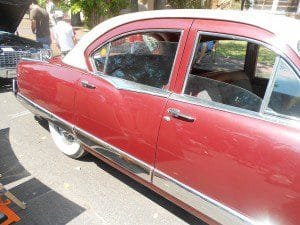The Kaiser Motor Corporation, formerly the Kaiser -Frazer Corporation, was one of several independent auto makers who fell victim to the Big Three when the post World War Two car demand began to wane. The biggest challenge for the non-three major auto makers, Ford GM and Chrysler, was having the financial resources necessary to tool up for new designs.

In other words, to keep pace with their peers, the independents had to spend large sums of money to produce new models which the public demanded. During the time that Henry J. Kaiser and Joseph W. Frazer were partnered tofether the company produced automobiles under each name. When Frazer departed the company in 1953 because he and Kaiser couldn’t get along well, the Frazer nameplate went as well.
All of the cars built by Kaiser-Frazer and then by Kaiser Motor Corporation were built at the company’s Willow Run factory. The Willow Run plant was located about 30 miles west of Detroit Michigan. There really is a lot of history connected with Willow Run and World War Two. An aircraft factory was built there in 1941. The Willow Run plant was producing an incredible one bomber per hour by August 1944.

Willow Run had also been the major Detroit airport prior to the building out of Detroit Metropolitan Airport, several miles closer in to the city.
The Kaiser Dragon shown was a luxury hardtop model. Included with this car was a gold plated hood ornament, a glove box nameplate and power steering. The engine, a flat head six cylinder, put out 118 HP. Prior to the 1953 model year, the Dragon was simply a trim option in 1951, not a separate model. Beginning in 1953, the Kaiser Dragon was a new model. This coincided with the new name of the Kaiser Motor Corporation.
The two things that the Kaiser Dragon had going against it was it’s relatively high price and the fact that it’s speed time from 0 to 60 MPH was considered slow. Kaiser’s main competitor would have been GM’s Buick. Most people would consider the Kaiser Dragon as a sales failure although it’s a great vintage car for today’s auto collectors. The best estimate of sales figures for the 1951 trim package model and the 1953 full model was about 1,600. This fact by itself makes the 1953 Kaiser Dragon a rare find.
When a vintage car collector talks about the Kaiser Dragon, he or she is really talking about car interior designer Carleton Spencer. The Kaiser Dragon’s interior was a Carleton Spencer creation form A to Z. It was said the Spencer based many of his interior design ideas from House and Garden Magazine.

Spencer was well known for his unique color selections. Spencer however is best known for his unusual alligator-pattern synthetic material called “Dragon Vinyl.” The term Dragon Vinyl was used so that buyers wouldn’t think they were sitting on real alligator skin. As mentioned above, this Dragon Vinyl was introduced as a trim option in the 1951 Kaiser models. That trim option in 1951 cost $125.
At about the same time that the company’s name was changed to Kaiser Motor Corporation in 1953, Kaiser picked up the assets and liabilities of the Willys-Overland Corporation. Willys-Overland was the builder of both passenger cars and jeeps. The name was then changed to Willys Motors. Willys had a manufacturing plant in Toledo Ohio.
In 1955 the company was put under the holding company of Kaiser Industries. Among other things, Kaiser had been a large west coast shipbuilder during World War Two in Richmond California. Kaiser was also a major steel maker.
The Kaiser designs eventually became outdated and as mentioned above, the retooling cost needed to keep pace with the Big Three was staggering. Nash Motor Car Company had the same problem which eventually led them to be a part of American Motors Corporation. The end of Kaiser as an independent United States auto builder came in 1955 when all passenger cars under the Kaiser and Wiilys nameplate was stopped. The Willow Run plant closed but the company continued to build jeeps out of the Toledo factory. In 1963 the jeep brand name was changed to Kaiser Jeep. In 1969 Kaiser Industries left the automobile business entirely and ended up selling the jeep line to American Motors Corporation.
(Photos from author’s private collection)